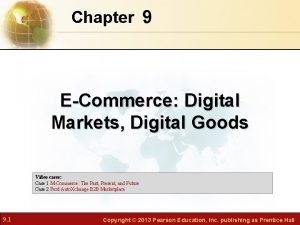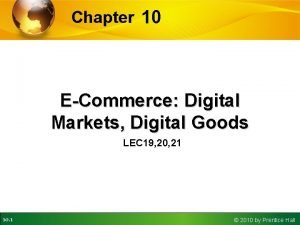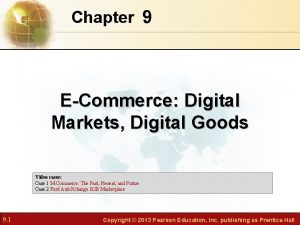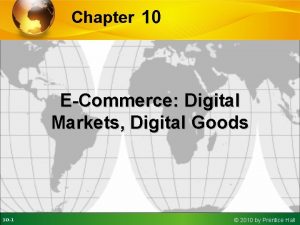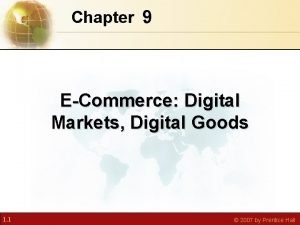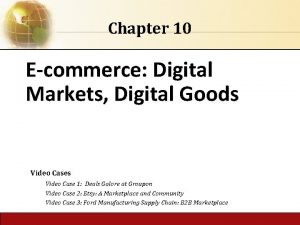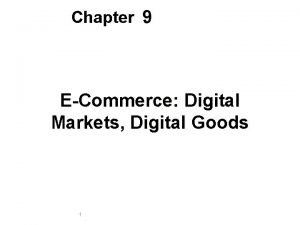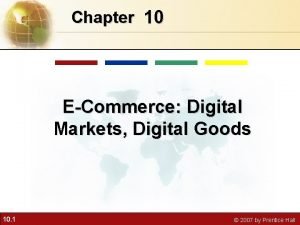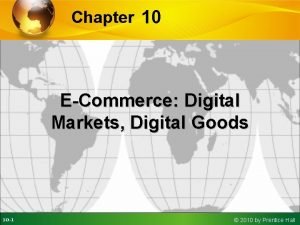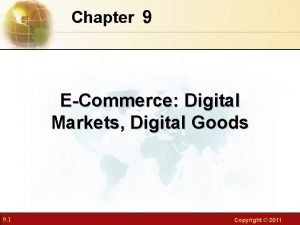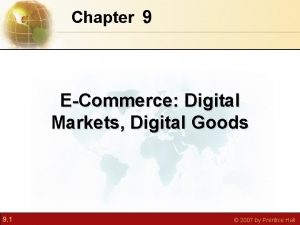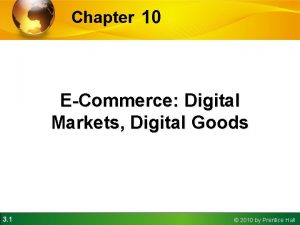Chapter 3 ECommerce Digital Markets Digital Goods 10
















- Slides: 16

Chapter 3 E-Commerce: Digital Markets, Digital Goods 10. 1 © 2010 by Prentice Hall

Management Information Systems Chapter 10 E-Commerce: Digital Markets, Digital Goods Electronic Commerce and the Internet • E-commerce • Use of the Internet and Web to transact business • Digitally enabled transactions • History of e-commerce • Began in 1995 and grew exponentially; still growing at an annual rate of 16 percent • Rapid growth led to market bubble • While many companies failed, many survived with soaring revenues • E-commerce today the fastest growing form of retail trade in U. S. , Europe, Asia 10. 2 © 2010 by Prentice Hall

Management Information Systems Chapter 10 E-Commerce: Digital Markets, Digital Goods Electronic Commerce and the Internet The Growth of E-Commerce Retail e-commerce revenues have grown exponentially since 1995 and have only recently “slowed” to a very rapid 16 percent annual increase, which is projected to remain the same until 2010. 3 Figure 10 -1 © 2010 by Prentice Hall

Management Information Systems Chapter 10 E-Commerce: Digital Markets, Digital Goods Electronic Commerce and the Internet • Eight unique features of e-commerce technology 1. Ubiquity • Internet/Web technology available everywhere: work, home, etc. , and anytime 2. Global reach • The technology reaches across national boundaries, around Earth 3. Universal standards • One set of technology standards: Internet standards 4. Richness • Supports video, audio, and text messages 10. 4 © 2010 by Prentice Hall

Management Information Systems Chapter 10 E-Commerce: Digital Markets, Digital Goods Electronic Commerce and the Internet • Eight unique features (cont. ) 5. Interactivity • The technology works through interaction with the user 6. Information density • Vast increases in information density—the total amount and quality of information available to all market participants 7. Personalization/Customization: • Technology permits modification of messages, goods 8. Social technology • The technology promotes user content generation and social networking 10. 5 © 2010 by Prentice Hall

Management Information Systems Chapter 10 E-Commerce: Digital Markets, Digital Goods Electronic Commerce and the Internet • Key concepts in e-commerce • Digital markets reduce • Information asymmetry • Search costs • Transaction costs • Menu costs • Digital markets enable • Price discrimination • Dynamic pricing • Disintermediation 10. 6 © 2010 by Prentice Hall

Management Information Systems Chapter 10 E-Commerce: Digital Markets, Digital Goods Electronic Commerce and the Internet The Benefits of Disintermediation to the Consumer The typical distribution channel has several intermediary layers, each of which adds to the final cost of a product, such as a sweater. Removing layers lowers the final cost to the consumer. Figure 10 -2 10. 7 © 2010 by Prentice Hall

Management Information Systems Chapter 10 E-Commerce: Digital Markets, Digital Goods Electronic Commerce and the Internet • Key concepts in e-commerce (cont. ) • Digital goods • Goods that can be delivered over a digital network • E. g. , Music tracks, video, software, newspapers, books • Cost of producing first unit almost entire cost of product: marginal cost of producing 2 nd unit is about zero • Costs of delivery over the Internet very low • Marketing costs remain the same; pricing highly variable • Industries with digital goods are undergoing revolutionary changes (publishers, record labels, etc. ) 10. 8 © 2010 by Prentice Hall

Management Information Systems Chapter 10 E-Commerce: Digital Markets, Digital Goods Electronic Commerce and the Internet • Internet business models • Pure-play models • Clicks-and-mortar models • Social Network • • • Online meeting place Social shopping sites Can provide ways for corporate clients to target customers through banner ads and pop-up ads • Online marketplace: • Provides a digital environment where buyers and sellers can meet, search for products, display products, and establish prices for those products 10. 9 © 2010 by Prentice Hall

Management Information Systems Chapter 10 E-Commerce: Digital Markets, Digital Goods Electronic Commerce and the Internet • Content provider • Providing digital content, such as digital news, music, photos, or video, over the Web • Online syndicators: Aggregate content from multiple sources, package for distribution, and resell to third-party Web sites • Service provider • Provides Web 2. 0 applications such as photo sharing and interactive maps, and services such as data storage • Portal • “Supersite” that provides comprehensive entry point for huge array of resources and services on the Internet 10. 10 © 2010 by Prentice Hall

Management Information Systems Chapter 10 E-Commerce: Digital Markets, Digital Goods Electronic Commerce and the Internet • Virtual storefront: • Sells physical products directly to consumers or to individual businesses • Information broker: • Provides product, pricing, and availability information to individuals and businesses • Transaction broker: • Saves users money and time by processing online sales transactions and generating a fee for each transaction 10. 11 © 2010 by Prentice Hall

Management Information Systems Chapter 10 E-Commerce: Digital Markets, Digital Goods Electronic Commerce Types of Electronic Commerce • Business-to-consumer (B 2 C) • Business-to-business (B 2 B) • Consumer-to-consumer (C 2 C) • Mobile commerce (m-commerce) 10. 12 © 2010 by Prentice Hall

Management Information Systems Chapter 10 E-Commerce: Digital Markets, Digital Goods Electronic Commerce Payment Systems • Types of electronic payment systems • Digital wallet • Stores credit card and owner identification information and enters the shopper’s name, credit card number, and shipping information automatically when invoked to complete a purchase • Accumulated balance digital payment systems • Used for micropayments ($10 or less) • Accumulating debit balance that is paid periodically on credit card or telephone bills 10. 13 © 2010 by Prentice Hall

Management Information Systems Chapter 10 E-Commerce: Digital Markets, Digital Goods Electronic Commerce Payment Systems • Stored value payment systems • Enable online payments based on value stored in online digital account • May be merchant platforms or peer-to-peer (Pay. Pal) • Digital checking • Extend functionality of existing checking accounts to be used for online payments • Electronic billing presentment and payment systems • Paying monthly bills through electronic fund transfers or credit cards 10. 14 © 2010 by Prentice Hall

Management Information Systems Chapter 10 E-Commerce: Digital Markets, Digital Goods Electronic Commerce Payment Systems • Digital payments systems for m-commerce • Three types of mobile payment systems in use in Japan • Stored value system charged by credit cards or bank accounts • Mobile debit cards • Mobile credit cards • In the U. S. , the cell phone has not yet evolved into a mobile payment system 10. 15 © 2010 by Prentice Hall

All rights reserved. No part of this publication may be reproduced, stored in a retrieval system, or transmitted, in any form or by any means, electronic, mechanical, photocopying, recording, or otherwise, without the prior written permission of the publisher. Printed in the United States of America. Copyright © 2010 Pearson Education, Inc. Publishing as Prentice Hall 10. 16 © 2010 by Prentice Hall
 Unique features of digital markets
Unique features of digital markets E-commerce: digital markets, digital goods
E-commerce: digital markets, digital goods E-commerce digital markets digital goods
E-commerce digital markets digital goods Product classifications
Product classifications Progressive tax
Progressive tax Merit good vs public good
Merit good vs public good Publik goods
Publik goods Example of digital goods
Example of digital goods Spp digital goods
Spp digital goods Why study financial markets and institutions
Why study financial markets and institutions Chapter 4 cultural dynamics in assessing global markets
Chapter 4 cultural dynamics in assessing global markets Characteristics of buyer behaviour
Characteristics of buyer behaviour Chapter 9 expanding markets and moving west
Chapter 9 expanding markets and moving west Analyzing business markets
Analyzing business markets Business markets and business buyer behavior
Business markets and business buyer behavior Chapter 18 the markets for the factors of production
Chapter 18 the markets for the factors of production Business buyer behavior refers to the
Business buyer behavior refers to the







